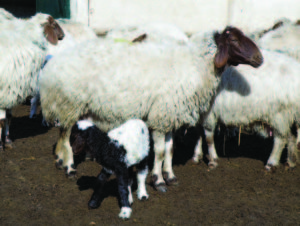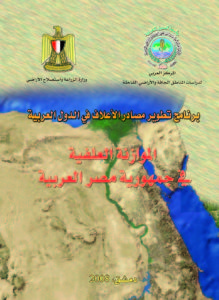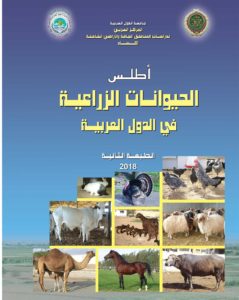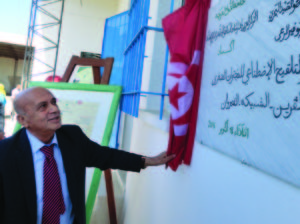Animal Wealth Department
Tasks:
- Improving the productive and reproductive performance of the most important indigenous Arabian animal breeds.

- Surveying, evaluating and developing the fodder resources in the Arab countries, as well as improving their use efficiency.
- Studying the carrying capacities and the farm animals feed requirements.
- Transferring packages of developed techniques to the breeders and Arab research centers including the methods of reproduction control, artificial insemination and embryo transfer. •Surveying and evaluating the animal wealth resources in the Arab countries and conserving the animal biodiversity.
- Documenting and disseminating the results of researches and studies.
- Training the technical staff and animal breeders in the various fields of the department’s activities.
Programs and Projects:
The department of animal wealth carries out its activities via the following program and projects:
Program for Genetic Improvement and Husbandry of Small Ruminants
Objectives:
- Improving the genetic efficiency of sheep and goats in the Arab countries.
- Improving the environmental and administrative conditions and developing the production system.
- Using modern techniques in the genetic evaluation and selection.
Components:
Project for Improving Sheep Production in the Arab Countries:
This project is implemented at a number of governmental stations and sheep breeders’ farms in many Arab countries. It includes the following sheep breeds: Awassi in Syria, Iraq, Jordan, and Lebanon; Barqi in Egypt; Barbari in Tunisia; Awlad Jalal in Algeria; and the indigenous sheep in Libya and Yemen.
Project for Improving Goat Production in the Arab Countries:
This project is implemented at a number of governmental stations in Syria and in six other Arab countries. The work in the project depends on the selection and crossbreeding of some local goats with Shami goats. ACSAD’s Ezraa research station for improvement and propagation of Shami goats is considered as a pilot station in the genetic improvement of Shami goats.
Program for Developing Feed Resources:
Objectives:
- Surveying the conventional and non-conventional feed resources in the Arab countries.
- •Identifying the nutritional value of the available feed resources in the Arab countries.
- Disseminating modern techniques to improve the nutritional value and processing of the agricultural residues and agro-industry residues.

Components:
- Editing and publishing the studies about the feed balance in the Arab countries.
- Carrying out researches on the use of tree by-products (olives, date palm) in animal feeding.
- Establishing small units for processing the agricultural by- products and distributing them among small breeders.
Program for Arabian Horses and Camel Research and Development
Objectives:
Using suitable techniques to improve the productive and reproductive efficiency of camels in the arid area.
- Improving production and marketing conditions of camel products to improve the income of the small breeders.
- Cooperating with the concerned institutions in the Arab countries for the purpose of inventorying Arabian horses’ numbers.
- Propagating the superior horse breeds by using bio-techniques.
- Providing expertise to the associations of Arabian pure horses in the Arab countries.
Components:
Project for Camel Research and Development:
- Highlighting the social and economic importance of camels in the Arab arid areas.
- Increasing the awareness of camels via research and studies carried out in the member countries.
- Participating in equipping laboratories specialized in camel research in the member countries.
- Holding seminars, training courses and workshops for the Arab technical staff in the field of camel development and products.
- Publishing periodical publications on camels and establish a website for the camel research network.
- Preparing and presenting research projects on camels to funding institutions.
Project for Arabian Horses Conservation and Development:
- Developing a database on superior Arabian horse breeds
- Establishing laboratories for superior Arabian horse artificial insemination and embryo transfer in the Arab countries.
- Training and rehabilitating technical staffs in the fields of modern technology transfer and use in horse breeding and care.
Program for Development and Use of Artificial Insemination and Embryo Transfer Techniques:
Objectives:
- Developing the technique of artificial insemination in sheep, goats. and horses in the Arab countries and disseminating its use as an alternative for the distribution of live males.
- Disseminating the excellent genetic resources of the elite animals (Shami goats and Awassi sheep) characterized by high genetic value, via sending their semen straws and embryos to the Arab countries.
- Developing methods of reproduction control in the animals of the arid areas.
- Establishing gene banks of the frozen embryos of the promising breeds which are threatened with extinction.
- Providing experience for establishing, equipping, and operating the laboratories of artificial insemination and embryo transfer in the Arab countries.
- Propagating the excellent horse breeds using biotechnologies.
- Providing experience and services for the Arabian horse breeders’ cooperatives in the Arab countries.
Components:

- Accelerating the genetic improvement of the Awassi sheep and Shami goats in Syria, Jordan, Lebanon, and Iraq.
- Carrying out cross-breeding between Awassi sheep or Shami goats and some local breeds of sheep and goats in Yemen, Libya, Egypt, Saudi Arabia and Qatar.
- Establishing pure herds of Shami goats in the Arab countries via embryo transfer technique.
- Establishing a database to follow up the activities of the artificial insemination laboratories in Syria, Libya, Algeria and Tunisia and the results of using the semen in the Arab countries.
- Training Arab staff on the use of artificial insemination and embryo transfer techniques for goats, sheep and horses.
- Dissemination of the artificial insemination and embryo transfer techniques for the Arabian horses in Syria.
- Conducting studies for establishing, supplying and operating laboratories for artificial insemination and embryo transfer, in addition to gene banks in the Arab countries.
Program for Inventory and Characterization of Animal Genetic Resources in the Arab Countries
Objectives:
- Completing and updating data on appearance characterization of agricultural animal genetic resources in the Arab countries.
- Identifying the genetic print of agricultural species and breeds in the Arab countries.
- Preparing an atlas on agricultural animals in the Arab countries.
Components:
The program includes the following projects:
– Project of “Preparation of Atlas on Agricultural Animals in the Arab Countries”.
– Project of “Identification of Genetic Print for Livestock Breeds in the Arab Countries”.
– Project of “Establishment of Regional Gene Banks for Animal Genetic Resources Conservation in the Arab Countries”.
– Project of “Genetic Improvement of Local Poultry Breeds”.
– Project of “Genetic Diversity of Small Ruminants”.
Program for Control of Trans-boundary Epidemics and Diseases
Objectives:
- Developing research projects on the epidemic knowledge of the most important contagious diseases in the Arab countries.
- Assisting Arab countries in establishing contagious disease control programs and developing early warning systems.
- Increasing Arab countries’ capacities in the fields of animal disease diagnosis and epidemic control.
- Monitoring the prevalence of common diseases and promoting awareness on that.
- Evaluating animal health care in the Arab countries.
- Developing descriptive maps for contagious diseases, and geographical maps and satellite analysis for the most important changes of contagious diseases.
Components:
- Coordinating with Arab countries in the fields of epidemic control and epidemic mapping.
- Conducting training courses which aim to increase Arab countries’ capacities in the fields of epidemics, epidemic survey and field and laboratory diagnosis of contagious diseases.
- Providing research projects on epidemic survey, and capacity building for the supporting authorities.
- Cooperating with research centers and laboratories in the field of animal diagnosis.
-
Main training courses:
- Using genetic characteristics to evaluate the performance of small ruminants.
- Using bio techniques to improve the reproductive efficiency of small ruminants.
- Using artificial insemination and embryo transfer in sheep and goats for accelerating genetically progress.
- Improving the agricultural by-products and processing animal feed.

- Developing camel production, processing and marketing of camel products.
- Conserving animal diversity and establishing gene banks.
- Health, feeding, and reproduction of the Arabian horses.



